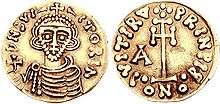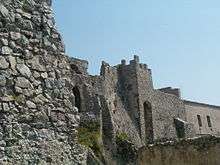Arechis II of Benevento

Arechis II (also Aretchis, Arichis, Arechi or Aregis) (died 26 August 787) was Duke (and later Prince) of Benevento, in Southern Italy, from 758 until his death. While he sought to expand Benevento's influence into areas of Italy still controlled by the Byzantine Empire, he also had to resist attacks by Charlemagne, who was building a Frankish empire and had conquered northern Italy.
Arechis descended from the Lombards who had invaded the Italian peninsula in the late sixth century and established a Lombard kingdom in northern Italy with its capital at Pavia, and two independent duchies in southern Italy, at Spoleto and Benevento.
Arechis was the son of Duke Liutprand, whom he succeeded in 756. Initially Arechis continued to use the title duke of Benevento. After the Lombard kingdom fell to Charlemagne in 774, however, probably as a gesture of independence, Arechis adopted the title prince of Benevento until his death in 787.
Around 757 Arechis married Adelperga, a daughter of the north Italian Lombard king, Desiderius. Arichis thus established friendly (but largely independent) relations with Desiderius, which lasted until the Lombard kingdom fell to the Franks in 774 and Desiderius was deposed. The Beneventan couple produced five children, three boys and two girls.

By eighth century standards, Adelperga and Arichis were notable patrons of culture. Adelperga commissioned the major Lombard writer Paul the Deacon to produce his Historia Romana, a textbook of Roman history which was widely used during the rest of the Middle Ages. (Some historians also argue that they commissioned Paul's more famous Historia gentis Langobardorum although this is uncertain.) Arichis arranged for the transfer of saints' relics to the newly commissioned church of Santa Sofia in Benevento. This still survives, albeit heavily restored. It is decorated with rare eighth-century frescoes. He also put resources into building works at Salerno, including a new palace and castle. Salerno became an increasingly important port and city from Arechis's reign onwards. Major south Italian monasteries, such as Montecassino and San Vincenzo al Volturno, also received substantial donations from him.
Arechis was the duke when Charlemagne conquered the north Italian Lombard kingdom in 774 and made himself king of the Lombards. Although Arechis refused to submit to Charlemagne, Benevento was left largely unmolested, probably because it was simply too far away to be reached easily and Charlemagne had many other calls on his time. In the same year Arechis adopted the title of "prince of Benevento". He also issued a handful of laws. Both these acts were probably intended as a gesture of defiance against Charlemagne, since hitherto no duke of Benevento had ever legislated - only the Lombard kings. Since Charlemagne now styled himself king of the Lombards, Arechis was effectively rejecting Charlemagne's right to this title.
In 776, Arechis was probably involved in a Lombard conspiracy to throw off Frankish domination. Charlemagne successfully crushed this revolt, which was mostly focused in Friuli, in north-east Italy. Arechis does not seem to have provided much practical support for the rebellion and Charlemagne was forced to hurry back north of the Alps, rather than dealing with Arechis. Once again, geographical distance had protected Arechis from the Franks.
Arechis's Beneventan state continued to skirmish with and try to seize territory from the neighbouring Byzantine duchy of Naples. At some point, however, perhaps in the mid-780s, Arechis reached an agreement with the duke of Naples set out in a document called a 'pactum'. This sets out detailed provisions dealing with landholding and dispute settlement. It was perhaps intended to free Benevento to deal with the looming Frankish threat.
This crystallised in 787, when Charlemagne advanced into south Italy and besieged Capua, another important town in the principality of Benevento. Arechis left Benevento itself and retreated to his new centre, the port of Salerno. Under pressure, Arechis apparently submitted to Frankish suzerainty. As Einhard, Charlemagne's biographer, describes it in his Vita Caroli Magni:
He [Charlemagne] afterwards entered Italy in person with his army [787], and passed through Rome to Capua, a city in Campania, where he pitched his camp and threatened the Beneventans with hostilities unless they should submit themselves to him. Their duke, Aragis, escaped the danger by sending his two sons, Rumold and Grimold, with a great sum of money to meet the King, begging him to accept them as hostages, and promising for himself and his people compliance with all the King's commands, on the single condition that his personal attendance should not be required. The King took the welfare of the people into account rather than the stubborn disposition of the Duke, accepted the proffered hostages, and released him from the obligation to appear before him in consideration of his handsome gift. He retained the younger son only as hostage, and sent the elder back to his father, and returned to Rome, leaving commissioners with Aragis to exact the oath of allegiance, and administer it to the Beneventans. He stayed in Rome several days in order to pay his devotions at the holy places, and then came back to Gaul [787].

Superficially, Charlemagne seemed to have imposed himself on Benevento. Arechis had paid tribute and one of his sons was being held hostage as a guarantee of Benevento's loyalty. Frankish influence was also given formal expression. Traditionally Benevento had produced and used gold coinage but from 787 the Beneventan mint began to strike silver coins too, similar to those issued by Charlemagne's Frankish kingdom. Both the new silver and the traditional gold coins, as well as Beneventan legal documents, all started to include Charlemagne's name and title alongside those of Arechis. The inclusion of titles on coins and in charters was considered an important marker of political authority.
However, Einhard overstates Charlemagne's success. Frankish influence in Benevento proved to be very short-lived. When in 788, both Grimoald's elder brother, Romuald, and Arechis himself died, Grimoald, who was being held hostage by Charlemagne, succeeded as prince of Benevento. Unwisely Charlemagne released Grimoald in return for an oath of loyalty. Grimoald did not keep this promise and, by c. 791, in effect proclaimed himself independent and successfully resisted the Franks. Later, Grimoald tried to throw off Frankish suzerainty, but Charlemagne's sons, Pepin of Italy and Charles the Younger, forced him to submit in 792.
Sources
- Einhard. The Life of Charlemagne. Translated by Samuel Epes Turner.
- King, P. D. (1987). Charlemagne: Translated Sources. Lancaster.
- Noble, T. F. X. (1984). The Republic of St. Peter: the Birth of the Papal State, 680–825. Philadelphia.
- Oman, Charles (1914). The Dark Ages, 476–918. London.
- Wickham, C. (1981). Early Medieval Italy. London.
| Regnal titles | ||
|---|---|---|
| Preceded by Liutprand |
Duke of Benevento As Prince from 774 754–787 |
Succeeded by Grimoald III |